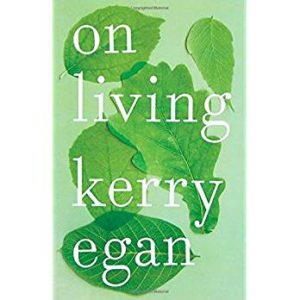Several weeks ago my dad sent me a text to say he’d just finished reading Kerry Egan’s new book, On Living, and it made him think of me. My dad works as a chaplain in a senior housing community and Kerry Egan is a hospice chaplain, but Dad said the book was about more than hospice work and gave me enough hints to the book’s content that I immediately clicked over to our library website and put it on hold.
 I haven’t been reading much lately, but David picked the book up for me a couple days before Christmas and there it sat at the top of my stack when I was poking around for something to do toward the end of last week. On Living is an accessible book, starting with the layout. Within the hardbound green covers are pages with wide margins and plenty of white space between lines of text. A bit of an aside – Pantone announced their annual color of the year in December and chose Pantone 15-0343 as the color for 2017. “Greenery is a fresh and zesty yellow-green shade that evokes the first days of spring when nature’s greens revive, restore and renew.” Greenery is the color of life. And, while not quite Pantone 15-0343, the color of life is the cover of Egan’s book, made more complete by the image of 5 life-sized leaves collected there. They are the color of spring.
I haven’t been reading much lately, but David picked the book up for me a couple days before Christmas and there it sat at the top of my stack when I was poking around for something to do toward the end of last week. On Living is an accessible book, starting with the layout. Within the hardbound green covers are pages with wide margins and plenty of white space between lines of text. A bit of an aside – Pantone announced their annual color of the year in December and chose Pantone 15-0343 as the color for 2017. “Greenery is a fresh and zesty yellow-green shade that evokes the first days of spring when nature’s greens revive, restore and renew.” Greenery is the color of life. And, while not quite Pantone 15-0343, the color of life is the cover of Egan’s book, made more complete by the image of 5 life-sized leaves collected there. They are the color of spring.
Egan is a good storyteller and I was easily drawn to her side in this collection of stories where she regularly sat bedside with people through the dying and stood with their loved ones after. Her reflections are laced with honesty and she includes points of her own failure and fear. Through it all she sifts for meaning. And in this work, I was sold. With her stories, Egan draws focus to the very essence of living. “Things are never only as they appear. My hospice patients have taught me that. There are always layers to people’s lives, unseen memories under every face, every decision, every movement or lack of movement. There is always gray between the black and white.”
Throughout the book Egan weaves a grey thread from her own life into her storytelling by including some details about the drug induced psychosis she acquired during the birth of her first child and endured for months following. She integrates the telling of her own traumatic break with reality even as she examines the nature of self and soul in the living and dying of her patients. “Do we have an essential soul, or is our identity at the mercy of what happens to us?” My experience with a traumatic brain injury more than a decade ago gives explicit shape to these questions in my own life and I may wrestle for the answers until the moment I die.
Egan’s search for meaning in her stories of the dying and the living is accessible, honest, and rich. I am grateful for her voice and I found deep resonance in the stories she told and the questions she raised. “Is your life one of regret or hope? Does it have to be one or the other? Is your body the locus of trauma, or a source of joy? Can it be both at the same time? Can you find kindness toward yourself and others amid your pain and anger and fear? Is there something real in all the facades and personas we create, or in the mysteries we encounter? Can life be both beautiful and crushing at the same moment?”
Both. And.
I think, Yes.